This post may contain affiliate links. Please see our disclosure policy.
Roasted tomato basil soup is a delicious homemade tomato soup recipe for canning, and it’s the perfect way to preserve a bumper crop of tomatoes to enjoy once those chilly autumn days arrive.
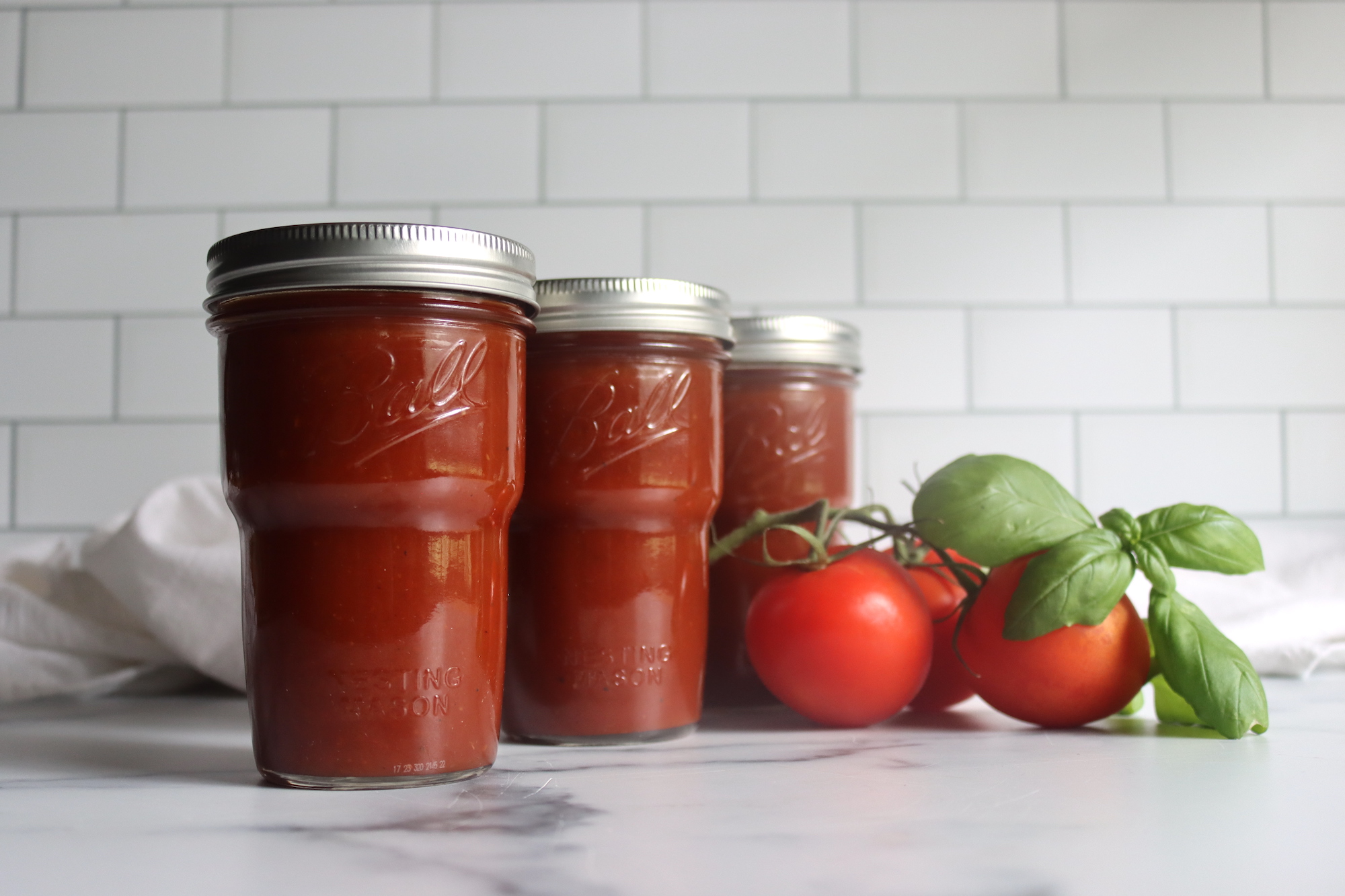
Autumn means the beginning of tomato soup weather here in Vermont, and it’s also when we’re harvesting homegrown tomatoes by the bucket full. Our basil plants are the size of an unwieldy toddler, and we’re buried in everything we need to make a truly spectacular bowl of home-canned tomato soup.
Ball Canning developed this particular recipe, which is a tested pressure canning recipe that doesn’t include any vinegar or lemon juice, so you get all that savory tomato flavor without the extra acid. As a result, there’s no sugar in this recipe either, just great tomato flavor.
If you don’t want to use basil, that’s perfectly fine; it’s optional. You can season the soup with other green herbs (like parsley) or make a plain roasted tomato soup. The choice is yours!
I’ve canned this batch in Ball Canning’s Nesting Mason Jars, designed to stack in storage when empty. To me, that’s not their real benefit, though. They look like a drink tumbler, and I’ve been looking for a smooth soup to make for heat and sip enjoyment right out of the jar. The perfect work lunch!
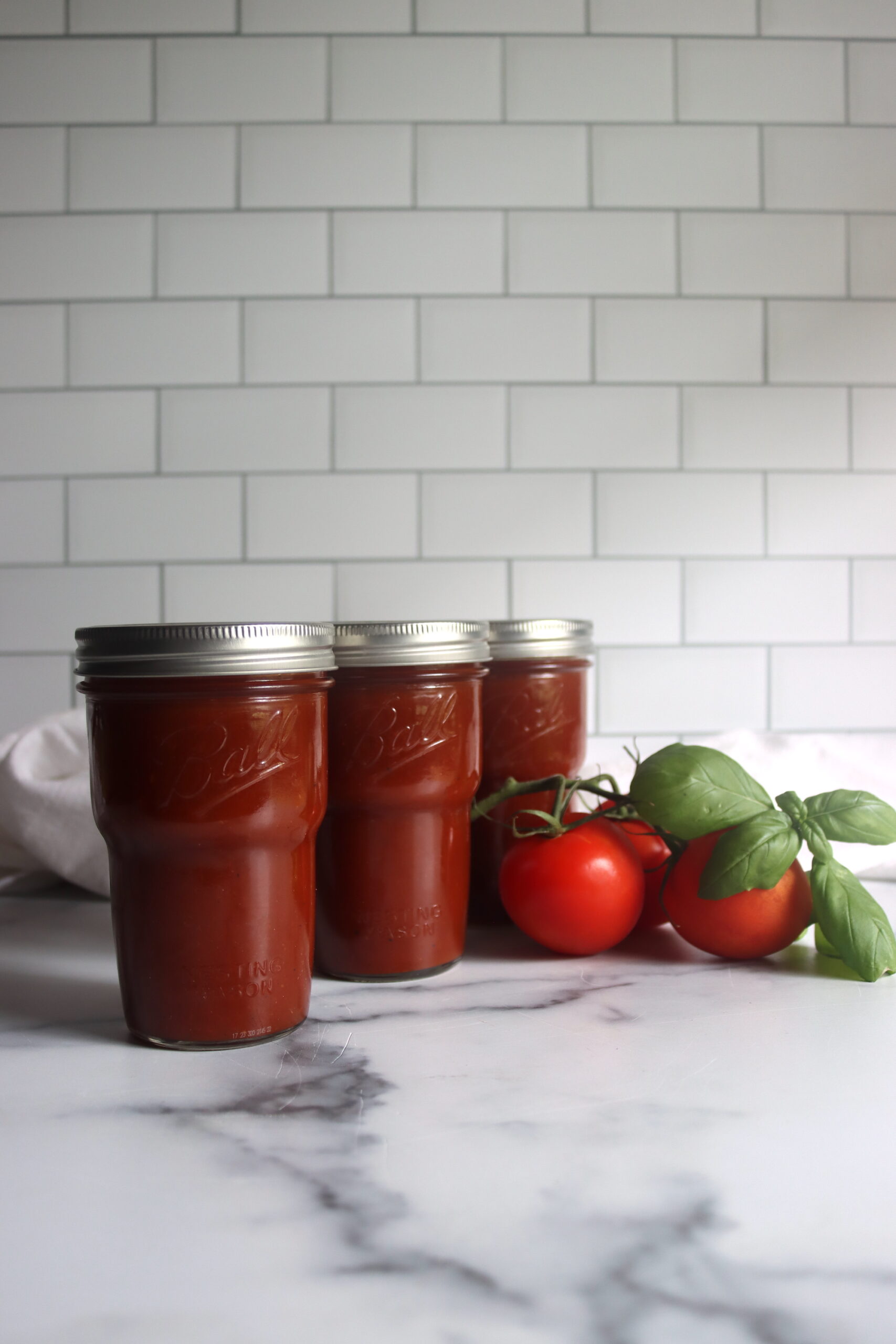
Ingredients to Tomato Basil Soup
This is a tested pressure canning recipe adapted from The All New Ball Book of Canning and Preserving. To make about 6 pints or 3 quarts of home-canned tomato soup, you’ll need the following:
- 8 lbs plum tomatoes, cored and halved (or 10 to 12 lbs slicing or heirloom tomatoes)
- 5 tsp. salt, divided
- 2 tsp. ground black pepper, divided
- 1 Tbsp. olive oil
- 2 cups chopped onions
- 4 cloves garlic, minced
- 1 cup dry white wine
- 4 cups vegetable or chicken stock
- 1 cup basil leaves, tightly packed
This recipe roasts the tomatoes to help bring out their natural sweetness, so it doesn’t include any added sugar as most tomato soups do. If you’d like to add a bit of sugar, that’s fine for canning, but I like this one savory.
Use vegetable or chicken stock for the best flavor, but lacking that, water works too as a liquid. The white wine really makes the flavors pop, but it’s not strictly required in this recipe. You can use more broth/stock in place of the wine, or use water and a tablespoon of vinegar to get a similar flavor.
This is a tested pressure canning recipe, so you don’t need to add lemon juice or vinegar, which helps keep the acidity down for those who are more sensitive to acidity in tomato soups.
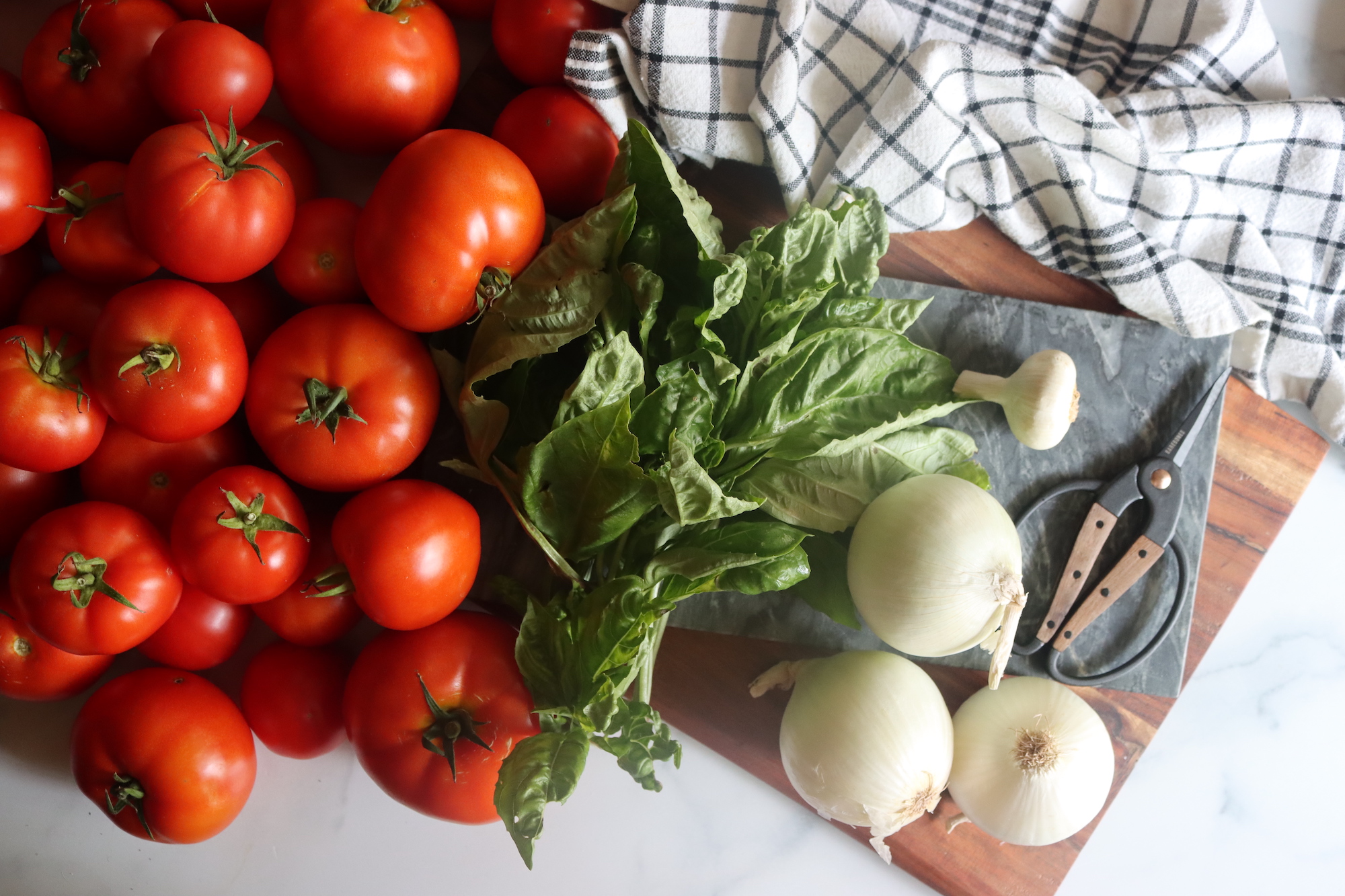
Roasted Tomato Basil Soup
This soup comes together beautifully and with minimal cooking time because you start by concentrating the flavor of the tomatoes by roasting them in the oven before they go into the soup pot.
Preheat the oven to 375 F.
Core the tomatoes and slice them in half, top to bottom. Remove the seeds with a spoon (or a quick squeeze over a bowl), and arrange the tomatoes cut side up on a baking sheet.
Sprinkle the tomatoes with 1 Tbsp of salt and 1 tsp of pepper.
Roast the tomatoes for about 45 minutes, until the tomatoes are very soft and have started to dry out a bit. Peel the roasted tomatoes and coarsely chop. At this point, they’re peeled, seeded and roasted.
(If you want to skip the peeling and seeding steps, roast the tomatoes and then process everything through a food mill with a fine mesh to remove the peels and seeds. I think it’s easier to scoop out the seeds first, then slip the peels after roasting as they come off so quickly. Then I don’t have to do all those extra food mill dishes, but to each their own. I tried this with multiple different methods, using both a food mill and a mesh strainer to remove the seeds on various batches, and it’s much quicker to scoop the seeds first and then slip the peels. )
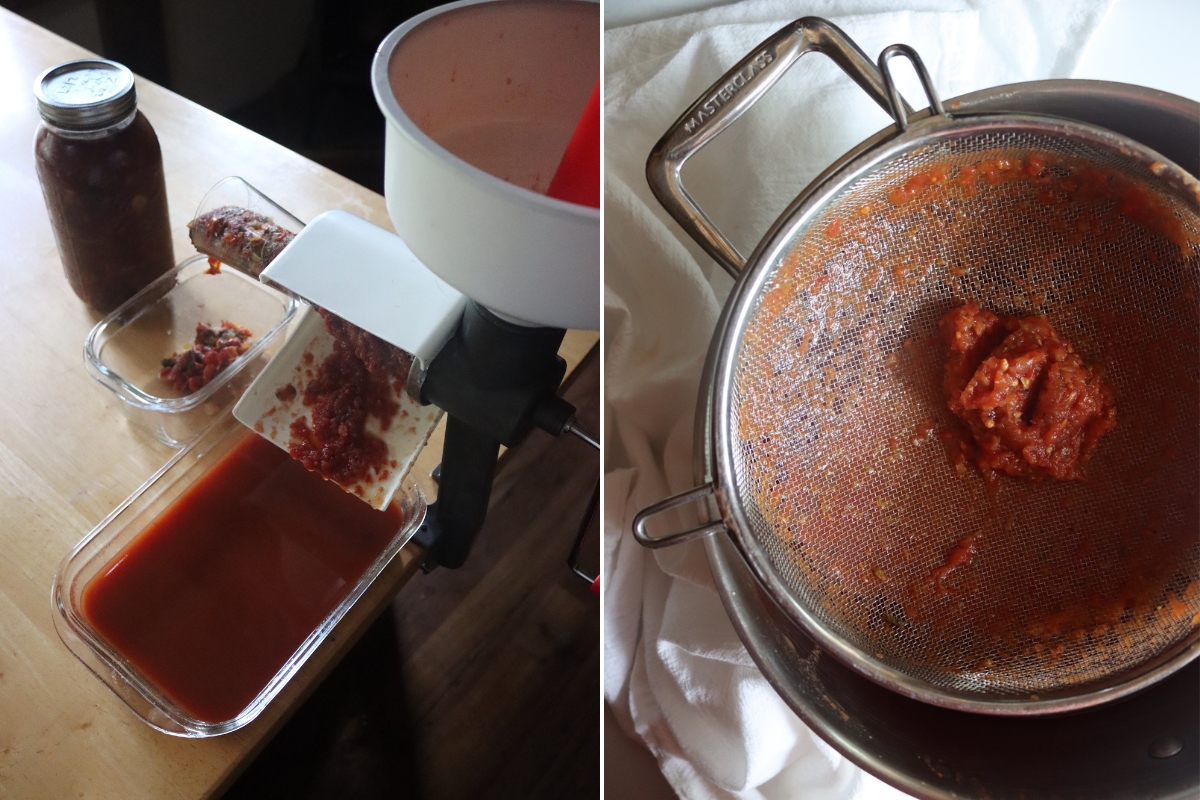
Add the olive oil to a pot, as well as onion, garlic, and remaining salt and pepper. Cook over medium heat until fragrant but not browned, about 8 to 10 minutes.
Add white wine and simmer for about 10 minutes, until most of the wine evaporates. Add in tomatoes, stock, and basil.
Cook for 20 minutes, until thoroughly heated. While the soup cooks, pre-heat your pressure canner.
Process in a blender, or use an immersion blender to make the soup completely smooth. If using a blender, you’ll probably need to work in batches.
Once the soup is smooth, return it to the pot and bring it back to a simmer to prepare for pressure canning.
If you’re not canning, the soup is fully cooked at this point, and you can just serve it as is or store in the refrigerator for up to a week. If you are canning, it’s time to get out your pressure canner!
Canning Tomato Basil Soup
If you’re not familiar with pressure canning, start by reading my beginner’s guide to pressure canning so you understand all the steps.
To can tomato soup, ladle the hot soup into prepared canning jars, leaving 1-inch headspace.
Add 2-piece canning lids and tighten to finger tight. Load into your preheated pressure canner.
Close the lid and vent the steam for 10 minutes, then add the canning weight and bring the canner up to pressure.
Once at pressure, process pint jars for 50 minutes and quart jars for 60 minutes.

Pressure Canning Altitude Adjustments
With pressure canning, the processing times stay the same at higher altitudes, but the pressures change. Here are the altitude adjustments for pressure canning tomato soup:
For dial gauge pressure canners:
- 0 to 2,000 feet in elevation – 11 lbs pressure
- 2,001 to 4,000 feet in elevation – 12 lbs pressure
- 4,001 to 6,000 feet in elevation – 13 lbs pressure
- 6,001 to 8,000 feet in elevation – 14 lbs pressure
For weighted gauge pressure canners:
- 0 to 1,000 feet in elevation – 10 lbs pressure
- Above 1,000 feet – 15 lbs pressure
Serving Tomato Basil Soup
This soup is pretty much ready to go right out of the jar. Just simmer for 10 minutes to thoroughly heat through and serve.
It’s especially good with homemade grilled cheese sandwiches!
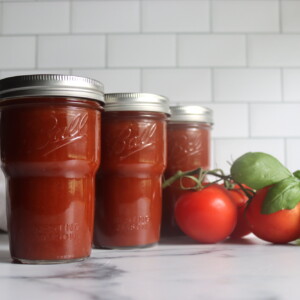
Roasted Tomato Basil Soup
Equipment
Ingredients
- 8 lbs plum tomatoes, cored and halved (or 10 to 12 lbs slicing or heirloom tomatoes)
- 5 tsp. salt, divided
- 2 tsp. ground black pepper, divided
- 1 Tbsp. olive oil
- 2 cups chopped onions
- 4 cloves garlic, minced
- 1 cup dry white wine
- 4 cups vegetable or chicken stock
- 1 cup basil leaves, tightly packed
Instructions
- Preheat the oven to 375 F.
- Core the tomatoes and slice them in half, top to bottom. Remove the seeds with a spoon (or a quick squeeze over a bowl, and arrange the tomatoes cut side up on a baking sheet.
- Sprinkle the tomatoes with 1 Tbsp of salt and 1 tsp of pepper.
- Roast the tomatoes for about 45 minutes, until the tomatoes are very soft and have started to dry out a bit. Peel the roasted tomatoes and coarsely chop.
- Add the olive oil to a pot, as well as onion, garlic, and remaining salt and pepper. Cook over medium heat until fragrant but not browned, about 8 to 10 minutes.
- Add white wine and simmer for about 10 minutes, until most the wine evaporates. Add in tomatoes, stock and basil.
- Cook for 20 minutes, until thoroughly heated.
- While the soup cooks, pre-heat your pressure canner.
- Process the soup in a blender, or use an immersion blender to make the soup completely smooth. If using a blender, you'll probably need to work in batches.
- Once the soup is smooth, return it to the pot and bring it back to a simmer to prepare for pressure canning.
- To can tomato soup, ladle the hot soup into prepared canning jars, leaving 1-inch headspace.
- Add 2-piece canning lids and tighten to finger tight. Load into your preheated pressure canner.
- Close the lid and vent the steam for 10 minutes, then add the canning weight and bring the canner up to pressure.
- Once at pressure, process pint jars for 50 minutes and quart jars for 60 minutes, adjusting pressure to altitude.
Notes
For dial gauge pressure canners:
- 0 to 2,000 feet in elevation – 11 lbs pressure
- 2,001 to 4,000 feet in elevation – 12 lbs pressure
- 4,001 to 6,000 feet in elevation – 13 lbs pressure
- 6,001 to 8,000 feet in elevation – 14 lbs pressure
For weighted gauge pressure canners:
- 0 to 1,000 feet in elevation – 10 lbs pressure
- Above 1,000 feet – 15 lbs pressure
Nutrition
Nutrition information is automatically calculated, so should only be used as an approximation.
Vegetarian Soup Canning Recipes
Looking for more savory vegetarian soups for home canning?
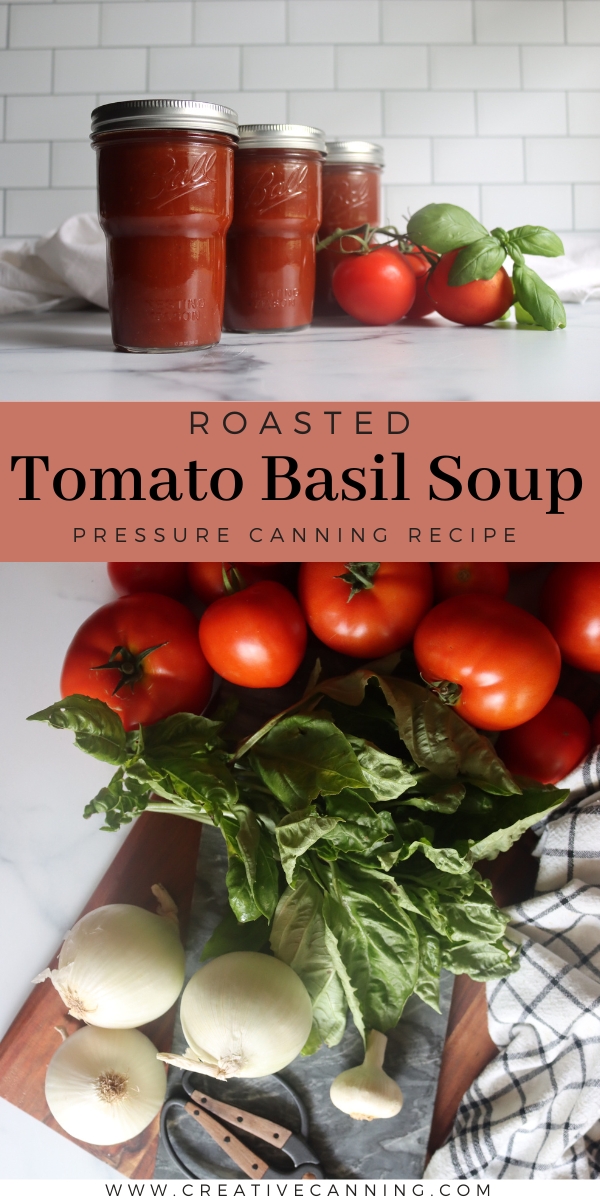
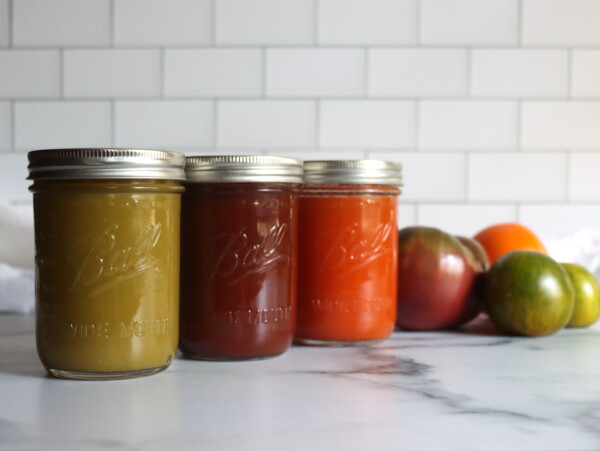
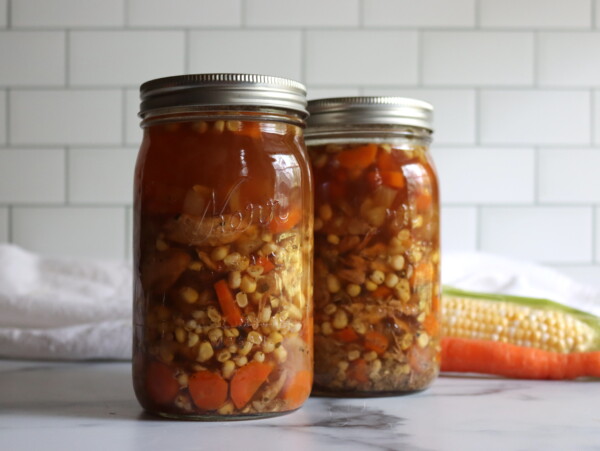
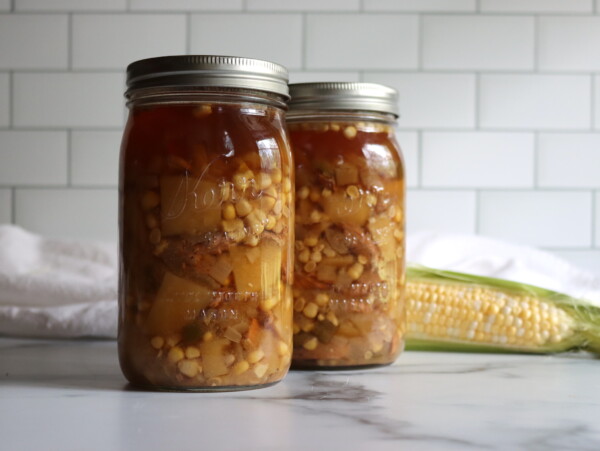
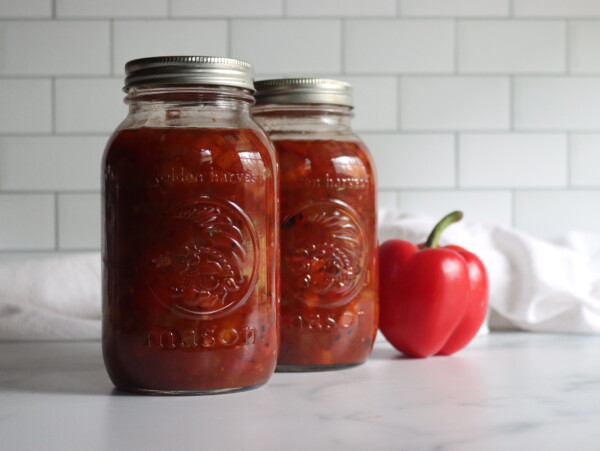
I was wondering can Roma tomatoes be used for this recipe?
Yes, that’s perfectly fine. Enjoy!
I’ve been making delicious tomatoes basil soup for a few years. I lost my original recipe and started using others but could not get the taste or results I wanted. I discovered Ceative Canning site and thought I would give it a try. I am pleasantly happy with this recipe. Some times I can it but most time my family and I just eat it, freeze it or freeze dry it. I’m making it today to take to a church activity tomorrow night for. I’m sure I’ll get request from many for the recipe after they eat it.
Wonderful! I’m so glad it’s so popular when you make it! And freeze drying it is a great idea too.
Can this be done in an instant pot or do you need to have a pressure canner?
If you’re canning in jars, you need a pressure canner. You can make the soup itself in an instant pot if you want, but you cannot use an instant pot as a canner. (More on that here: https://creativecanning.com/instant-pot-canning/). If you don’t have a pressure canner, you can store this in freezer safe jars in the freezer until you need it.
Can I make this with dried basil instead? I’m at the end of the season here and have no fresh basil left. I made my first batch a few weeks ago and it was fantastic!
Of course you can use dried basil, that’s perfectly fine. Guessing the amount might be tricky, but I’d go with maybe 2 teaspoons to 1 tablespoon as a good starting point. Let me know how it turns out for you!
If I do not have a pressure canner, is there anything I can add such as lemon juice or citric acid to each pint or quart, then boiling water can?
This particular recipe is only tested as a pressure canning recipe, but there are a number of waterbath canning recipes for tomato soup. You can find those listed here: https://creativecanning.com/tomato-soup-recipes-for-canning/
Can I leave the skin and seeds in. I don’t mind the texture but wasn’t sure if it would adversely affect it in some way. Thank you!
The skins and seeds can make the soup bitter in some instances, so I don’t recommend it.
For the skins, the national center for food preservation says they need to be removed in tomato canning recipes to reduce the bacterial load in the canner (as the outsides have more potential for bacteria than any other part). They give that as a blanket statement, but then they do actually publish a bunch of recipes that don’t have you peel the tomatoes, so it’s a bit confusing how strictly necessary that is for canning safety. The seeds don’t have any canning safety implications, they’re just removed for texture and taste.
Thank you!!!
I’m not an expert but I have been researching canning for a few months and processing time is also relative to the area in which you live. I have not found a recipe for tomato basil soup on the usda website for safe canning. However I’m still going to try this recipe and freeze it. Ty
Process times (or pressures) are relative to where you live only in that where you live determines your altitude. For waterbath canning, you adjust the canning time to altitude, and for pressure canning (like this recipe) you leave the time the same but adjust the pressure. This particular recipe is not from the USDA, but was developed and tested by Ball Canning.
Can this be made with frozen tomatoes?
Yes, that should work fine. You’ll end up with a lot of liquid when you defrost them, and you can drain it and cook the soup down less when you make it (or include it into the pot and follow the recipe as is). Enjoy!
Hi! I’m excited to try this. I’ve never cooked with white whine…is there specific one you’d recommend for this recipe? I’m totally clueless lol. Thanks!
Great question, and no worries, you definitely don’t need to be a wine expert for this one. Any dry white wine works well in tomato soup, something like Pinot Grigio, Sauvignon Blanc, or Chardonnay. You just want to avoid anything sweet (like Moscato or Riesling). If you wouldn’t mind drinking a small glass of it, it’ll taste great in the recipe, and most of the alcohol cooks off during simmering, leaving just a subtle depth of flavor.
When I made this, I used an inexpensive Pinot Grigio.
I sent a comment about the processing time but don’t see a response. Have you been successful using the 50 or 60 minutes at 15# pressure stated in the recipe?
Just got back to you a minute ago. Sorry about that, I’ve been away from my computer all week.
A VERY good recipe for Roasted Tomato Basil soup. It came out perfect. I will be making more as soon as more of my tomatoes become ripe. Thank you for the recipe!
You’re quite welcome!
I love the soup. However, I question the processing time. I have to wonder if there is an error, should it be 5 or 6 minutes rather than 50 or 60? In hindsight, I should have recognized this, but always being extra cautious about canned foods I followed the instructions.
I have been pressure canning for over 50 years and have never had so many jars that have not sealed. I made a double batch and ended up with 7 quarts. I assured that there was plenty of head space. I was surprised and disappointed when only three sealed. A lot of the contents spilled out of the jars.
Hi Judy,
This recipe is straight out of Ball Canning’s new cookbook, and the times are their tested times. I didn’t have any issue with the canning time or sealing rate on this recipe. All my jars sealed, no liquid loss and they all tasted great. However, I do agree with you, it seems like a long process time. The reason for the long time, as best I can determine, is that this particular recipe isn’t acidified as many are. Generally, tomato soup canning recipes have a good bit of added acidity which allows them to be either waterbath canned or pressure canned for just a few minutes.
This one isn’t acidic, which is great for flavor, but means more canning time. Even still, looking at similar recipes from the NCHFP for things like their “Tomato and Veggie Juice Blend,” which also has no added acidity and added veggies, and their pressure canning times are 35 and 40 minutes (source: https://nchfp.uga.edu/how/can/how-do-i-can-tomatoes/tomato-and-vegetable-juice-blend/). My assumption is that this recipe is a bit longer because the soup comes out a bit thicker than a straight tomato juice.
Can you freeze the soup instead of canning?
Yes, of course! Just be sure to use freezer safe containers (not all jars are freezer safe). Enjoy!
I didn’t weigh my tomatoes because I have a lot of different variety. I have a pot of sauce from them all. How much tomato “sauce” would you suggest going into the recipe? How much sauce does the 8lbs produce?
So that’s a tricky question. When you run the tomatoes through a food mill to get the seeds and skins out, you get something called “passata” which is basically a sauce that hasn’t been cooked down but doesn’t count as “sauce” to most people yet (including the National Center for Home Food Preservation). But some people call that sauce, so it’s confusing.
I pulled measurements from the NCHFP, and they have pounds of tomatoes to make “thin sauce” which is cooked down by about 1/3, or thick sauce, which is cooked down to about half volume. Here’s what they say on conversions of pounds tomatoes to sauce:
Quantity: For thin sauce – An average of 35 pounds is needed per canner load of 7 quarts; an average of 21 pounds is needed per canner load of 9 pints. A bushel weighs 53 pounds and yields 10 to 12 quarts of sauce-an average of 5 pounds per quart.
For thick sauce – An average of 46 pounds is needed per canner load of 7 quarts; an average of 28 pounds is needed per canner load of 9 pints. A bushel weighs 53 pounds and yields 7 to 9 quarts of sauce-an average of 6½ pounds per quart.
10/10 amazing. It’s so so good
So glad you liked it!
Can this recipe be done in hot water bath canning?
This particular recipe is for pressure canning, but I do have other tomato soup recipes that can be waterbath canned. They’re listed here: https://creativecanning.com/tomato-soup-recipes-for-canning/
I’m looking for processing time in a hot water bath process. I had a bad experience with pressure canning, so back to the “old fashion” way. Thank you in advance, Kay
This one is designed as a pressure canning recipe because it doesn’t have added acid, and it has chicken or veggie stock in it. There are, however, a number of tested waterbath canning recipes for tomato soup. I have all of them listed in this article: https://creativecanning.com/tomato-soup-recipes-for-canning/
This looks great! How many pint jars or quart jars will this recipe make (approximately)?
This recipe makes 6 pints or 3 quarts.